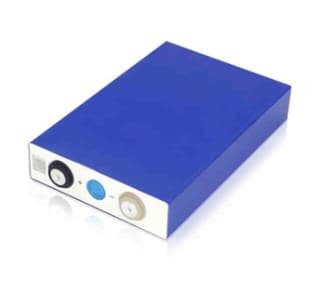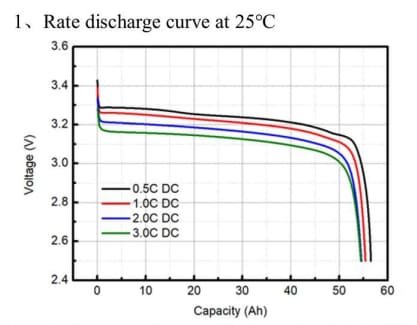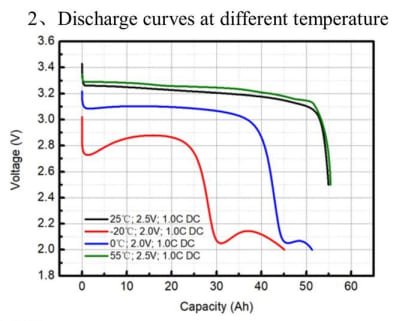EVE LF50K 3.2v 50Ah LiFePO4 battery cell
- Home
- EVE LiFePO4 Battery Cells
- EVE LF50K 3.2v 50Ah LiFePO4 battery cell
EVE LF50K 3.2v 50Ah LiFePO4 battery cell
EVE LF50K 3.2v 50Ah LiFePO4 battery cell is a lithium prismatic cell. This battery cell is often used in applications such as power and small energy storage. After this LiFePO4 cell, the manufacturer made a model with the same capacity but different dimensions: LF50F. Regarding the difference between LF50K and LF50F, this article compares them in terms of dimension, price, performance, etc. If you are interested in this, please go to the end of this article.
EVE LF50K 3.2v 50Ah LiFePO4 battery cell Datasheet



Battery Model: LF50k
Nominal Voltage: 3.2v
Rated Capacity: 50Ah
Rated Energy: 160Wh
ACR(1KHz): ≤ 0.7mΩ
Weight: 1395±50g
Cyele Life: ≥7000
Storage Humidity: <95%
Recommend SOC Window: 10%~90%
Self-discharge Rate per Month: ≤3%/per month
Charging Cut-off Voltage: 3.65v
Discharging Cut-off Voltage: 2.5v
Dimension: 185.3±0.5*135.3±0.5*29.3±0.7mm
Standard Charge/Discharge Current: 1C/1C (25±2℃)
Maximum Constant Charge/Discharge Current: 3C/3C
Maximum Pulse Charge/Discharge Current: 5C/5C
Charging working temperature: 0℃~55℃
Discharge working temperature: -20℃~55℃
EVE LF50K 3.2v 50Ah LiFePO4 battery cell Electrical Performance Graphs



difference between EVE LF50F and EVE LF50K
About EVE LF50f and EVE LF50k, these two batteries are both LiFePO4 battery prismatic cell. They have the same rated voltage, rated capacity, rated energy. The main differences between them are as follows:
Dimension
EVE LF50f (H*L*W): 129.8±0.5*148.3±0.5*26.7±0.5mm
EVE LF50k (H*L*W): 185.3±0.5*135.3±0.5*29.3±0.7mm
From the above data, it can be seen that the LF50f is much lower than the LF50k, the length is slightly longer, the thickness is similar, the LF50f belongs to the “short and fat type”, the LF50k belongs to the “thin and tall type”.
Cyele Life
EVE LF50f Cyele Life: ≥1500 times
EVE LF50k Cyele Life: ≥7000 times
The LF50k has many more cycles than the LF50f.
Charge/discharge rate
EVE LF50f Standard Charge/Discharge Current: 0.5C/0.5C (25±2℃)
EVE LF50f Maximum Constant Charge/Discharge Current: 1C/1C
EVE LF50f Maximum Pulse Charge/Discharge Current: 1.2C/1.2C
EVE LF50k Standard Charge/Discharge Current: 0.5C/0.5C (25±2℃)
EVE LF50k Maximum Constant Charge/Discharge Current: 3C/3C
EVE LF50k Maximum Pulse Charge/Discharge Current: 5C/5C
Compared to the LF50f, the LF50k has a higher charge/discharge rate and supports fast charging.
internal resistance
EVE LF50f ACR(1KHz): ≤ 2mΩ
EVE LF50k ACR(1KHz): ≤ 0.7mΩ
The LF50k has less internal resistance than the LF50f.
applications
Based on the performance of these two battery cells, we can see that the LF50f is more suitable for energy storage applications that do not require a high rate of discharge, while the LF50k is more suitable for power applications such as golf carts and electric vehicles.
summary
To sum up, LF50k supports 3C discharge, has lower internal resistance, more cycle life and is more expensive. Therefore, it is more suitable for power applications. LF50f has lower discharge rate, higher internal resistance and less cycle times, but it is cheaper and more suitable for energy storage applications. If you want to know more about LF50F, please click: LF50F.
